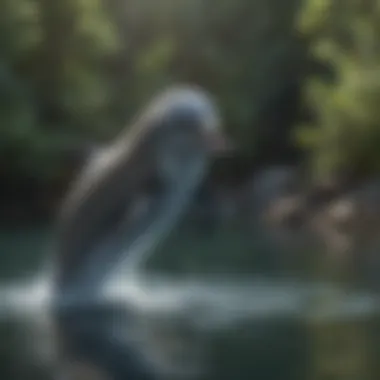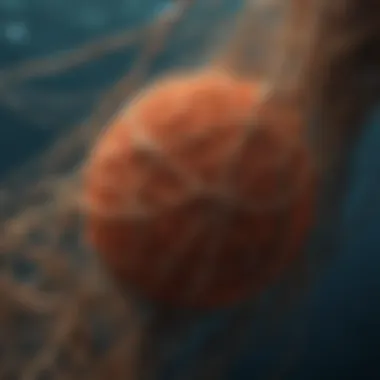Enemies of Dolphins: Understanding Marine Threats


Intro
Dolphins are remarkable creatures that captivate human imagination. They are often viewed as symbols of intelligence in the marine world. However, their lives are not without danger. Dolphins face several threats that affect their survival and the health of marine ecosystems. This article will explore these enemies in-depth, shedding light on the natural and human-induced challenges that dolphins encounter.
Understanding the threats dolphins face is crucial for the broader marine ecosystem. As apex predators, dolphins play an essential role in maintaining the ecological balance. By examining these threats, we gain insights into the intricate relationship within marine environments. Herein, we will navigate various dimensions, including natural predators, human interference, and environmental changes that hinder dolphin existence.
Foreword to Dolphin Ecology
Understanding dolphin ecology provides a baseline for appreciating the various threats these creatures face in their marine environment. Dolphins are often perceived as emblematic of oceanic health. Their welfare reflects broader environmental conditions, making it essential to study their behavior, habitat, and role in the ecosystem. This section lays the groundwork for subsequent discussions about both natural and anthropogenic threats to dolphins.
Overview of Dolphin Species
Dolphin species exhibit significant diversity, with more than 40 types identified worldwide. Common species include the bottlenose dolphin, the orca, and the spinner dolphin. Each species has unique characteristics, habitats, and behaviors. For instance, the bottlenose dolphin is known for its adaptability, often residing in coastal areas, while the orca, or killer whale, travels in pods and exhibits complex social behaviors.
- Bottlenose Dolphin: Frequently found in warm coastal waters. Known for their sociable nature.
- Orca: Apex predator with sophisticated hunting techniques and strong social bonds.
- Spinner Dolphin: Recognized for their spectacular acrobatics and preference for deeper waters.
The understanding of these variations is crucial. It informs conservation strategies and helps stakeholders recognize how specific threats impact each dolphin species differently.
Dolphins in Marine Ecosystems
Dolphins play a vital part in marine ecosystems. They serve as indicators of ocean health and contribute to the balance of marine life. Their feeding habits help regulate fish populations, which can prevent overgrazing on sea vegetation.
Dolphins are also preyed upon by larger species, reflecting their position in the food chain. Predators like sharks and orcas can significantly affect dolphin populations. Conversely, dolphin behavior can impact the distributions of smaller fish and other prey. This interrelatedness underscores the complexity of marine ecosystems.
In summary, dolphins are more than charismatic marine mammals; they are integral to the dynamics of their habitats. Recognizing their ecological role sets the stage for understanding the multitude of challenges they face, both from natural adversaries and from human activities that further complicate their survival.
Natural Enemies of Dolphins
Understanding the natural enemies of dolphins is significant in addressing their conservation and survival. Dolphins, despite being highly intelligent and social, are not without threats. Natural enemies include predatory species and competition among marine mammals. By exploring these threats, we get a clearer picture of how complex and interconnected the marine ecosystem is. This section highlights both direct predation and indirect competition that dolphins face, contributing to the overall landscape of threats impacting dolphin populations.
Predator Species
Predator species pose a direct threat to dolphins, often acting as natural enemies in the marine environment.
Sharks
Sharks are one of the most well-known predators of dolphins. Their role as apex predators contributes to the health of marine ecosystems. Sharks exhibit remarkable hunting skills, which can adversely affect dolphin populations. Their presence is significant as they help control dolphin numbers and keep the ecosystem in balance. One unique feature of sharks is their acute sense of smell, allowing them to detect prey from miles away. However, their natural predation can lead to decreased populations of dolphins, impacting the marine food web.
Killer Whales
Killer whales, or orcas, are another formidable predator of dolphins. They are highly social animals and often hunt in pods. Their strength and intelligence make them efficient hunters. Killer whales can target specific species of dolphins, which increases competition for food sources. A notable characteristic of killer whales is their varied diet, which can include fish, seals, and even other dolphins. This adaptability may result in increased stress on dolphin populations as orcas learn to exploit their vulnerabilities.
Large Fish
Large fish, such as tuna and swordfish, also contribute to the natural challenges dolphins face. While they may not hunt dolphins directly, they compete for similar food sources. Their larger size and predatory behavior can limit the availability of prey for dolphins. A key aspect of large fish in the marine ecosystem is their migratory nature, which can disrupt local dolphin feeding patterns. Dolphins often rely on specific areas for hunting, and competition with large fish can lead them to expend more energy to find food.
Natural Competition
Natural competition significantly affects dolphin survival and distribution. This section addresses how competing marine mammals and varying feeding strategies impact dolphins' access to resources.


Competing Marine Mammals
Competing marine mammals, such as seals and other cetaceans, create challenges for dolphins. They seek similar prey, which increases competition for food resources. The key characteristic of these competing species is their own hunting efficiency and social hunting strategies. This competition can hinder dolphins' ability to thrive in certain habitats. As they compete for the same ecological niche, dolphin populations can become stressed, potentially leading to declines.
Feeding Strategies
Feeding strategies among different marine species also contribute to the competition that dolphins face. Dolphins utilize echolocation as a meaningful hunting tool, but their prey may employ different strategies to escape. For instance, some species of fish and other marine organisms have developed school behavior, which complicates hunting for dolphins. The variety of feeding strategies adds complexity to the overall dietary landscape in which dolphins operate. This dynamic illustrates the constant struggle for survival within the marine ecosystem, highlighting the necessity for adaptability in dolphins.
Anthropogenic Threats
The threats dolphins face in their natural habitats often stem from human activities. Understanding these anthropogenic threats is crucial. They directly impact the populations and distribution of dolphin species, underline the intricate connections within marine ecosystems, and highlight the urgent need for conservation measures. Commercial fishing practices, habitat destruction due to development, and climate change are central topics that require detailed examination to appreciate their role in harming dolphin populations.
Commercial Fishing
Bycatch Issues
Bycatch refers to the unintentional capture of non-target species during fishing activities. This issue is significant as it leads to the death of many dolphins and other marine animals. Bycatch is a critical concern that underscores the consequences of fishing practices on the delicate balance of marine life. The impact of bycatch is considerable; it's estimated that hundreds of thousands of dolphins die each year due to this issue. This worrying characteristic emphasizes the importance of discussing bycatch in relation to dolphin conservation. Addressing bycatch is vital for promoting sustainable fishing practices and ensuring dolphin survival.
Overfishing
Overfishing occurs when fish stocks are harvested at a rate faster than they can replenish. This practice disrupts the food chain and can lead to a decline in dolphin populations. It is essential to highlight overfishing as a major element contributing to the degradation of marine ecosystems. The characteristic of overfishing—its capacity to undermine entire species—is critical. Overfishing presents numerous challenges as it can lead to competition for food among marine mammals, affecting their ability to thrive in their environment.
Habitat Destruction
Coastal Development
Coastal development poses a significant threat to dolphin habitats. As urban areas expand and infrastructure projects grow, natural marine environments become increasingly compromised. Key characteristics of coastal development include habitat fragmentation and loss of crucial breeding grounds. These factors merit attention as they directly impact dolphin populations. The unique feature of habitat destruction through coastal development is that it can be both irreversible and compounded over time. Addressing these challenges is necessary to protect dolphins and their ecosystems.
Pollution Effects
The pollution of ocean waters affects dolphins in various ways. Contaminants like plastic waste and heavy metals enter the marine ecosystem, harming the health of many species. A defining characteristic of pollution is its pervasive nature; it affects not only dolphins but also other marine life. The effects of pollution contribute to a degraded habitat, making it important to include this topic in discussions of dolphin conservation. Notably, understanding pollution's impact highlights the need for both prevention strategies and robust clean-up initiatives.
Climate Change Impacts
Temperature Rise
Global warming has raised sea temperatures, affecting the distribution and behavior of dolphin species. Temperature rise alters the availability of prey, which in turn affects dolphin feeding habits. This characteristic is crucial because it exposes changes in habitat ranges that dolphins may have to adapt to. The increasing temperatures pose both advantages and disadvantages; while dolphins may seek cooler waters, the long-term shifts in their habitats could disrupt established migration patterns.
Ocean Acidification
As CO2 levels in the atmosphere increase, ocean waters absorb a significant amount, leading to acidification. Ocean acidification negatively affects marine organisms, particularly those with calcium carbonate structures, like corals. Dolphins rely on healthy ecosystems to thrive, making this an essential aspect to consider. This characteristic of ocean acidification illustrates its detrimental effects on the broader marine environment. Recognizing the implications of acidification is vital for understanding the challenges dolphins face in maintaining their populations over time.
Addressing anthropogenic threats is essential to protect dolphins and the overall health of marine ecosystems.
Pollution as a Threat
Pollution represents a significant and multifaceted threat to dolphin populations and the broader marine ecosystem. The introduction of various pollutants into oceanic environments not only jeopardizes dolphin health but also disrupts the intricate balance of marine life. As intelligent creatures, dolphins rely heavily on their habitat's quality, and pollution directly impairs it. Understanding how different types of pollution affect dolphins can lead to better conservation strategies and public awareness efforts.
Plastic Pollution
Plastic pollution stands as one of the most pervasive forms of environmental degradation affecting marine species, including dolphins. Over the past few decades, the oceans have become a repository for millions of tons of plastic waste. This form of pollution is particularly alarming because it presents various risks to marine life, including ingestion and entanglement.


Ingestion Risks
Ingesting plastic is a critical issue for dolphins. These mammals often mistake plastic particles for food, leading to the consumption of harmful materials. This ingestion can result in severe internal injuries, malnutrition, and even death. The fact that such risks are escalating at an alarming rate highlights the need for swift and decisive action. Addressing this risk can significantly contribute to preserving marine health and, by extension, dolphin populations.
The key characteristic of ingestion risks is their invisibility; small plastic pieces can resemble natural prey and are often undetectable. Moreover, the bioaccumulation of toxins from ingested plastics can lead to a chemical imbalance in dolphins, directly impacting their health. Educating the public about this issue is a crucial step towards fostering awareness about the consequences of plastic pollution.
Entanglement Issues
Entanglement poses another severe risk associated with plastic pollution. Dolphins can easily become ensnared in discarded fishing nets, lines, and other plastic debris. Such encounters can lead to dire consequences, including restricted movement, injury, or chronic stress responses, ultimately affecting their well-being and survival. The commonality of entanglement situations underscores the importance of monitoring and cleaning ocean environments.
The key characteristic of entanglement issues is their immediacy; a dolphin may experience immediate danger from a single piece of plastic. The unique feature here is that these issues are often preventable through community-driven initiatives aimed at reducing plastic waste. Addressing entanglement offers the dual benefit of protecting dolphins while promoting a healthier marine landscape.
Chemical Pollutants
Chemical pollutants are another alarming source of danger for marine life, including dolphins. These substances typically originate from agricultural runoff, industrial discharges, and urban development, entering the oceans and causing contamination.
Heavy Metals
Heavy metals, such as mercury and lead, pose significant health risks to dolphins. These elements are non-biodegradable and accumulate in the marine food chain. As dolphins are apex predators, they are particularly susceptible to the toxic effects of heavy metals. This bioaccumulation can result in a range of health complications, including neurological damage and reproductive challenges.
The key characteristic of heavy metals is their persistence in the environment. Their contamination can lead to widespread ecological consequences that extend beyond immediate dolphin health concerns. Addressing this issue is vital for sustaining the overall health of marine ecosystems, which are interconnected with human health and well-being.
Pesticides
Pesticides can enter marine environments through agricultural runoff and pose another risk for dolphin populations. These chemicals can disrupt hormonal functions in marine wildlife, including dolphins, leading to reproductive abnormalities and impaired development in young.
The primary feature of pesticides is their potential for long-term ecological impact. As these toxic substances enter the food web, their effects multiply, influencing not only dolphins but also various marine species they rely on for food. Understanding and mitigating pesticide runoff is crucial for protecting dolphin health and the marine environment.
The intersection of various pollution sources significantly complicates conservation efforts aimed at safeguarding dolphins. Addressing these issues demands a multi-faceted approach involving public education, policy changes, and concerted local and global efforts.
The Role of Marine Conservation
Marine conservation plays a pivotal role in ensuring the survival of dolphins and the broader marine ecosystem. It reflects a commitment to protect marine life from the myriad threats that have been discussed. Engaging in conservation efforts can greatly benefit not just dolphins, but also the extensive web of life that exists beneath the ocean's surface.
The actions taken in marine conservation can mitigate many issues that dolphins face today. These include pollution, habitat destruction, and climate change. Protecting and restoring marine environments is necessary to sustain dolphin populations. With increased conservation awareness, there can be stronger policies that address these complex threats.
Protected Marine Areas
The establishment of protected marine areas (PMAs) is a fundamental strategy in marine conservation. These areas are designated zones where human activity is limited or regulated to protect marine biodiversity, including dolphin populations. PMAs offer safe havens for dolphins, allowing them to thrive without the fear of fishing, pollution, or other human-induced pressures.
Protected marine areas serve multiple functions, including:
- Habitat Protection: PMAs preserve critical habitats important for breeding, feeding, and migration of dolphins.
- Biodiversity Conservation: They enhance the overall health of marine ecosystems. A healthy ecosystem supports a wide range of species.
- Research Opportunities: PMAs offer scientists a space to study marine life with minimal human interference. This research can lead to better management practices.
Many countries have recognized the importance of PMAs and have initiated programs to create them. However, ongoing efforts need to raise awareness about their significance and how they impact marine conservation.
Restoration Efforts
Restoration efforts are equally important in marine conservation. They aim to rehabilitate degraded marine environments and reestablish natural ecosystems. Such initiatives can provide dolphins with healthier habitats conducive to their survival.


Restoration can take various forms, including:
- Rehabilitation of Seagrass Beds: Seagrass is crucial for many marine species, including dolphins. Replanting efforts can create rich feeding grounds that support their diet.
- Coral Reef Restoration: As coral reefs decline due to climate effects and other factors, restoration helps maintain biodiversity and protects the species that rely on these ecosystems.
- Removal of Invasive Species: Invasive species can outcompete native marine life, disrupting ecosystems. Efforts to remove them can facilitate the recovery of local populations, including dolphins.
Public Awareness and Education
Public awareness and education are vital components in addressing the threats dolphins face. These initiatives aim to enlighten the public about the significance of dolphins within marine ecosystems and the various challenges they encounter. Understanding these threats fosters a sense of responsibility among individuals, encouraging them to take action. In this age of environmental concerns, a well-informed public can significantly influence conservation efforts.
Educational campaigns serve to inform communities about the importance of preserving dolphin habitats and the broader marine environment. By disseminating knowledge regarding the detrimental impacts of pollution, overfishing, and climate change, these campaigns equip individuals with the information needed to make informed choices. They also emphasize the interconnectedness of life within the ocean, illustrating how the well-being of dolphins reflects the overall health of marine ecosystems. Through awareness, people can learn simple ways to contribute, like reducing plastic consumption and supporting sustainable seafood.
Furthermore, these programs can shape attitudes towards species conservation. By showcasing the intelligence and social structures of dolphins, educational campaigns create emotional connections that inspire individuals to engage more deeply with marine conservation issues. The emotional appeal can lead to increased participation in local conservation initiatives, fostering a community spirit and dedication to dolphin protection. A well-informed public can become advocates for environmental policies, further driving change on a more systemic level.
Influence of Education Campaigns
Education campaigns have a proven track record of raising awareness about marine conservation. Various organizations create targeted materials that focus on the survival needs of dolphins. This can include pamphlets, online resources, and community workshops.
Such initiatives typically focus on problematic areas affecting dolphin populations. Example topics include:
- Plastic Pollution: Highlighting the harmful effects of plastic waste in oceans.
- Fishing Practices: Discussing the impact of bycatch and unsustainable fishing on dolphin species.
- Climate Change: Outlining how changes in ocean temperature and chemistry affect dolphin migratory patterns.
By involving schools and community groups, these campaigns create a ripple effect. Individuals are more likely to share what they learn with others, enhancing the reach of the message. In the long run, education cultivates an understanding that leads to changes in behavior, fostering a culture of conservation.
Collaborative Efforts with NGOs
Collaboration between educational institutions and non-governmental organizations (NGOs) can amplify the impact of public awareness initiatives. NGOs often have resources and expertise in marine biology and conservation strategies. Partnering with them can enhance educational campaigns by providing accurate, research-based information and practical solutions.
These partnerships often yield joint initiatives, such as:
- Co-hosted Workshops: These can be on marine ecologies, dolphins, and threats they face.
- Awareness Drives: Joint campaigns can utilize social media platforms to reach a broader audience.
- Cleanup Events: NGOs can organize community cleanups, promoting hands-on involvement in conservation efforts.
When NGOs and educational entities work together, they can pool resources for greater efficiency and effectiveness. This collaboration not only raises awareness but also encourages community engagement in actionable conservation efforts, making a measurable difference in dolphin protection.
Culmination
The conclusion of this article encapsulates the significant threats dolphins encounter in their habitats. The survival of dolphins is linked closely to the overall health of marine ecosystems. By examining both natural predators and anthropogenic challenges, we uncover a complex array of consequences that dolphins face. This dual perspective helps us recognize that dolphin conservation is not just about saving one species; it is about preserving a balance within the marine environment.
Key points include:
- Understanding natural enemies, both in terms of predator species and competition for resources.
- Recognizing the impact of human activities, such as commercial fishing and habitat degradation, on dolphin populations.
- Identifying pollution as a critical threat and the consequences of chemical waste in oceans.
Addressing these issues leads to essential benefits not only for the dolphins themselves but also for marine ecosystems at large. When dolphins thrive, ecosystems are healthier, which in turn supports diverse marine life and contributes to sustainable fisheries.
Summation of Key Points
In summary, the factors discussed throughout this article reveal the intricate web of challenges dolphins encounter.
- Natural Predators: Sharks and killer whales, while part of a natural ecosystem, pose risks to dolphin juveniles and stressed populations.
- Human Impact: Overfishing and habitat loss threaten dolphin survival. Bycatch issues in fishing nets are particularly detrimental.
- Pollution: Plastic waste and chemical toxins significantly affect dolphin health and reproductive capabilities.
- Climate Change: Rising temperatures and ocean acidification alter habitats and food availability for dolphins.
Dolphins are not just victims of these threats; they serve as indicators of ocean health. Protecting them can facilitate a broader conversation about environmental stewardship.
Call to Action for Dolphin Conservation
The need for immediate action is clear. We must advocate for dolphin conservation through various means:
- Support organizations dedicated to marine wildlife protection, like the Marine Mammal Center
- Engage in local clean-up initiatives to reduce plastic pollution in oceans.
- Participate in or support educational campaigns aimed at raising awareness about the plight of dolphins.
- Urge policymakers to establish and enforce stricter regulations on fishing practices and pollution control.
The health of our oceans directly influences human well-being. Each individual action, though seemingly small, contributes to wider efforts that ensure dolphins can thrive in their natural environments. It is our responsibility to preserve these intelligent mammals and the ecosystems they inhabit.







